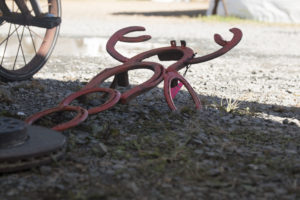Episode 7: That Ribbon of Highway

In the 1950s, the automobile was king. A new federal highway system and dreams of “urban renewal” took hold. But many of those highways are now broken and in need of repair.
This hour, we look into what’s behind the rebuild of one important New England interstate, and we remember the communities we lost during the urban renewal era, including one city’s Little Italy.
Later this hour, we discuss the important issues heading into this election for three New England states. And at New England’s biggest flea market, NEXT producer Andrea Muraskin finds that the people are as fascinating as the stuff on display.
Getting There
We’ve been closely watching proposals to build new high speed rail through the region. New routes could drastically reduce travel times between Boston and New York and points south.
The Federal Railroad Administration has been considering three plans with a variety of old and new pathways for the trains. A decision on a preferred route is expected sometime this fall.

A map of a portion of the National Railroad Administration’s plan for the Northeast Corridor shows a proposed line (in purple) that would run through the city center of Old Lyme, Connecticut. (Credit: Federal Railroad Administration)
Emails obtained by a group opposing a route through the coastal town of Old Lyme, Connecticut seem to show that the FRA has had a preferred route for a while… and yes, it’s the one that goes through that town. We speak with New London Day reporter Kimberly Drelich, who has has been covering the story.
In New England, Interstate 84 is well known and, well, hated. One of the reasons for that hatred is a short stretch that cuts right through the heart of Hartford, Connecticut.
When I-84 was built, it caused two big problems. First, it meant that all the interstate traffic was bottle-necked onto a twisting, turning, elevated roadway, with a series of complicated on and off ramps infusing new traffic into the mix, commuters, delivery trucks — locals just trying to get across town.

The I-84 Viaduct cuts right through downtown Hartford. Credit Ryan Caron King/WNPR
The second problem is a common one. When highways were built right through cities in the middle of the 20th Century, they destroyed neighborhoods, and physically separated communities. For an example of what this looks like, read Ryan Caron King’s story about a historic home that was spared the wrecking ball, but not the highway noise.
But how to fix the problem? We speak with Norm Garrick, a professor of civil engineering at the University of Connecticut, and author of a recent Citylab article about Rochester, New York’s attempt to fix a 1950s planning disaster.
We also learn the story of Portland, Maine’s Little Italy. It was one of many neighborhoods across America that was demolished as a result of urban renewal. The federal program introduced after World War II aimed to clear cities of so-called slums and blighted areas, making way for improved infrastructure and commercial development. Producer Georgia Moodie has our story.
CT/RI/VT Elections Roundtable
Remember those days when we used to talk about issues during a political campaign? Yeah, us neither. That’s why we wanted to sit down with smart political observers from around New England to talk about the big issues facing their states this year. From WNPR in Connecticut, Colin McEnroe from The Colin McEnroe Show and The Wheelhouse joins us. From Rhode Island Public Radio’s Political Roundtable, Maureen Moakley chimes in, and so does Vermont Public Radio capital bureau reporter Peter Hirschfeld.
Brimfield

A lobster made from horseshoes at the Brimfield Antiques Flea Market (Credit: Ziwei Zhang)
In the 1954 film Brigadoon, the protagonists discover a magical village that only appears for one day every hundred years. Brimfield, Massachusetts is kind of like that. The town only has about 3,500 permanent residents. But for a week in each of May, July, and September, the town transforms into a bustling tent city known as the Brimfield Antique Flea Market.
The market dates back to the 1950s and today boasts over 250,000 visitors, stretching half a mile down Route 20.
At a market like this, the stuff comes with stories, and NEXT producer Andrea Muraskin found plenty on her visit over the weekend.
About NEXT
NEXT is produced at WNPR.
Host: John Dankosky
Producer: Andrea Muraskin
Executive Producer: Catie Talarski
Digital Content Manager/Editor: Heather Brandon
Contributors to this episode: Jill Kaufman, Shannon Dooling, and Jennifer Mitchell
Music: Todd Merrell, Lightning on a Blue Sky by Twin Musicom, New England by Goodnight Blue Moon
We appreciate your feedback! Send praise, critique, suggestions, questions, story leads, and pictures of your own flea market finds to next@wnpr.org.


